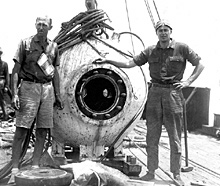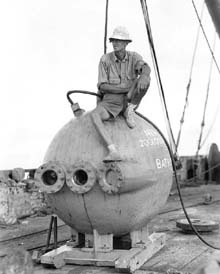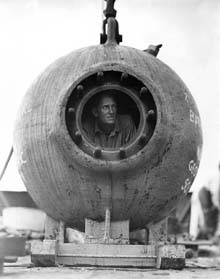
William Beebe (left) and Otis Barton standing next to the bathysphere. Click image for larger view and image credit.
A Link to the Past
August 15, 2005
Peter Auster
University of Connecticut
“If it is true that the greatest mysteries and the most wonderful places and happenings can be adequately described only in the simplest language, then any account of the abysses of ocean, the depths of the sea, should be in words of one syllable.”
William Beebe, Nat. Geo. Jan 1932 Vol. 61 “The Depths of the Sea”
“Incredible!! … Unbelievable!!” It is often such superlatives that I use to describe what we have seen on our dives on these seamounts. I am often one of only a few other people in the world to have seen light falling upon a species of deep sea fish in its natural habitat, going about it’s daily business of finding prey and avoiding predators. Humans have not been in this business of deep sea wildlife biology for very long.
However, today is the 71st anniversary of the dive made by William Beebe and Otis Barton one-half mile under the sea in their bathysphere. The bathysphere was a hollow steel ball that hung from a cable on a winch and carried two people to depths not yet visited by humans. In order to keep passengers alive for the hours they endured in small cramped quarters, oxygen was added to the air from a high pressure cylinder and exhaled carbon dioxide was removed by chemical “scrubbers”. They viewed the world outside the bathysphere through three small quartz viewports. The dark depths were illuminated by a light from inside the bathysphere that was pointed out one of the ports. Power for the lights and scrubber, as well as for two-way communication with the people on the ship overhead, came through a wire that was connected to and penetrated through the hull.
Unlike today, underwater photography was a primitive art. While experiments in producing images from shallow well lit seas were successful, working in the dark cold depths proved difficult. The sensitivity of film to light was remarkably poor and taking enough light underwater to make proper exposures was impossible. Beebe had a tried and true method of visualizing the things he saw. Else Bostelmann was an artist, a scientific illustrator, who produced stunning paintings of animals in action based on the descriptions of events by Beebe and his diving colleagues as well as samples of the organisms collected using towed nets. There was no way to collect samples from the bathysphere, it was only a platform to look out and wonder.
“When all is told of what we know at present of this no-man’s-place, the combined knowledge is relatively of kindergarten amount and quality, for we have only begun to penetrate this vast realm of life, still using the crudest of instruments.”
William Beebe, Nat. Geo. Jan 1932 Vol. 61 “The Depths of the Sea”
Beebe spent several years before conducting shallower as well as record breaking dives. However, he was not all that interested in breaking records but in applying this technology to the study of deep sea animals, so he could do the same types of research underwater that he did on land. His strategy was to define a small area of forest or sea and use multiple types of tools to exhaustively determine who lives there and how they make their living. We are trying to do the same thing today.
“… exploration under the ocean is really unearthly; we are penetrating a new world.”
William Beebe, Nat. Geo. Dec. 1932 Vol. 62 “A Wonderer Under Sea”
Beebe would be awed by our advancements in undersea exploration and research and surely amazed at our ability to directly observe, record video and still images, and sample communities of organisms at depths much beyond one half mile. Today our dive took us nearly a mile underwater, to the upper flanks and summit of an extinct undersea volcano. We counted and observed fishes generally not seen alive and collected corals and other deep sea creatures, some of which may be new species. We have the privilege of using one of the most advanced ROVs in the world and seeing parts of our planet not visited before by humans. Beebe would surely approve of what we are doing … we have come a long way … but there is such a long way to go, things to see, to understand, and to conserve.
“The only place comparable to these marvelous nether regions must surely be naked space itself, out far beyond the atmosphere, between the stars, where sunlight has no grip upon the dust and rubbish of planetary air, where the blackness of space, the shining planets, comets, suns, and stars must really be closely akin to the world of life as it appears to the eyes of an awed human being in the open ocean a half mile down.”
William Beebe, Nat. Geo. Dec. 1934 Vol. 66 “A Half Mile Down”
Sign up for the Ocean Explorer E-mail Update List.


























